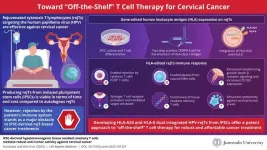(Press-News.org) In a discovery that opens the door to a less invasive way of treating some serious disorders before birth, UC San Francisco scientists have found that delivering medicine through amniotic fluid is as effective as delivering it to the fetal brain via cerebrospinal fluid. The experiment was done in mice with a genetic disorder called Angelman syndrome.
Treating genetic diseases like Angelman in utero could prevent serious symptoms that begin while the fetus is still developing. It’s also easier to access neurons in the fetal brain because the blood-brain barrier that normally acts as a filter to prevent molecules from reaching the brain is not yet fully formed.
The treatment uses therapeutic molecules called antisense oligonucleotides, or ASOs, that can alter the expression of genes through interactions with RNA, which creates proteins.
“ASOs are currently given to children with diseases affecting the nervous system,” said Tippi MacKenzie, MD, a fetal and pediatric surgeon at UCSF Benioff Children’s Hospitals and the senior author of the study, which appears in Molecular Therapy. “However, children who have a severe version of a genetic condition may have irreversible damage by the time they are born that cannot be addressed after birth.”
Previous research has shown that Angelman syndrome, a severe neurological condition marked by intellectual disabilities, seizures and abnormal gait, can be diagnosed before birth, and that expression of the part of the gene that causes the syndrome can be manipulated prenatally.
The treatment improved the motor function and learning of the mice pups after they were born. And injecting the therapy directly into the amniotic fluid allowed it to circulate into the intestines, lungs, liver, kidneys and stomach, and helped reinstate gene expression in critical parts of the brain.
“By injecting into the amniotic fluid, we could give a much higher dose than when we injected into the cerebrospinal fluid,” MacKenzie said. “Injecting this way also created a more ‘slow release’ approach.”
The researchers hope this will enable them to treat conditions such as pulmonary hypertension and cystic fibrosis prenatally.
“Both types of prenatal injections we tried, into the cerebrospinal fluid and into the amniotic fluid, allowed the therapy to penetrate deep regions of the brain that are critical areas to treat for Angelman Syndrome,” said Maria Clark, B.S., a UCSF research associate in MacKenzie’s lab. “This is a big hurdle to overcome when treating genetic conditions of the nervous system.”
The team is now working with a large animal model to determine whether ASOs delivered into the amniotic fluid can cross into the brain and spinal cord as well as they did in mice. They are also speaking to parents whose children are affected by Angelman syndrome and related disorders to understand their perspectives on seeking prenatal therapy.
Funding: The study was partially funded by BioMarin.
Co-authors: Please see paper for additional authors.
About UCSF: The University of California, San Francisco (UCSF) is exclusively focused on the health sciences and is dedicated to promoting health worldwide through advanced biomedical research, graduate-level education in the life sciences and health professions, and excellence in patient care. UCSF Health, which serves as UCSF's primary academic medical center, includes top-ranked specialty hospitals and other clinical programs, and has affiliations throughout the Bay Area. UCSF School of Medicine also has a regional campus in Fresno. Learn more at https://ucsf.edu, or see our Fact Sheet.
###
Follow UCSF
ucsf.edu | Facebook.com/ucsf | YouTube.com/ucsf
END
A better way to deliver fetal therapy for serious genetic disorders
2024-03-04
ELSE PRESS RELEASES FROM THIS DATE:
Researchers develop amphibian-inspired camouflage skin
2024-03-04
Inspired by amphibians such as the wood frog, investigators designed and synthesized a new type of camouflage skin involving one-dimensional photonic crystal structures assembled in three-dimensional flexible gels.
As described in Advanced Optical Materials, the camouflage skin can quickly recognize and match the background by modulating the optical signals of external stimuli. It demonstrated excellent mechanical performance, self-adaptive camouflage capabilities in response to complex surroundings, and long-term stability in real-world living environments. Bright structural color and mechanical flexibility were maintained even at temperatures as low as -80℃.
The advance ...
Network of quantum sensors boosts precision
2024-03-04
The quantum systems employed in quantum technologies, for example single atoms, are also very sensitive: any interaction with the environment can induce changes in the quantum system, leading to errors. However, this remarkable sensitivity of quantum systems to environmental factors actually represents a unique advantage. This sensitivity enables quantum sensors to surpass conventional sensors in precision, for example when measuring magnetic or gravitational fields.
Noise cancellation using correlation spectroscopy
The delicate quantum properties needed for sensing can be covered up ...
Robotic hip exoskeleton shows promise for helping stroke patients regain their stride
2024-03-04
Robotic Hip Exoskeleton Shows Promise for Helping Stroke Patients Regain Their Stride
A portable robotic device created by UMass Amherst researchers provides new avenue for making state-of-the-art gait rehabilitation methods more effective and accessible
AMHERST, Mass. – More than 80% of stroke survivors experience walking difficulty, significantly impacting their daily lives, independence, and overall quality of life. Now, new research from the University of Massachusetts Amherst pushes forward the bounds of stroke recovery ...
Conservation value of field research stations grossly misunderstood and underfunded according to 173 conservation scientists in new study
2024-03-04
SAN DIEGO – Funding of field conservation research stations worldwide has been drastically reduced since the beginning of the COVID-19 pandemic, raising the alarm of more than 170 conservation researchers representing 157 field stations in 56 countries in a new paper published in Conservation Letters. The authors contend that field research stations have a high return on investment and are essential and highly effective tools for biodiversity conservation.
Trillions of U.S. dollars were mobilized in economic recovery following the pandemic, yet the authors raise concerns ...
Study underscores social factors of low breast cancer screening in the US
2024-03-04
There is a pressing need to explore and understand which social determinants of health (SDOH) and health inequities act as significant influential factors that contribute to low breast cancer screening behaviors in the United States.
Health disparities have been consistently associated with delayed screening, which then contributes to higher mortality rates among both Hispanic and Black populations. Moreover, poverty, lack of education, neighborhood disadvantage, residential segregation, racial discrimination, lack of social support and social isolation ...
Nanomedicine research aims to transform treatment of aortic aneurysms
2024-03-04
Aortic aneurysms are bulges in the aorta, the largest blood vessel that carries oxygen-rich blood from the heart to the rest of the body. Smoking, high blood pressure, diabetes, or injury can all increase the risk of aneurysms, which tend to occur more often in Caucasian male smokers over the age of 65.
“The soft tissues that make up blood vessels act essentially like rubber bands, and it’s the elastic fibers within these tissues that allow them to stretch and snap back,” says Professor Anand Ramamurthi, chair of the Department of Bioengineering in Lehigh University’s P.C. Rossin College of Engineering ...
HIV medication can be used safely with gender-affirming hormone therapy
2024-03-04
New research definitively shows that HIV antiretrovirals can be taken together with gender-affirming hormone therapy without changing how well either drug works. The study findings can help healthcare providers address potential patient concerns that one drug will counteract the other.
“This study is the first head-to-head pharmacokinetic analysis of two common HIV medications and long-term feminizing hormone therapy use,” says Walter Kraft, MD, director of the Division of Clinical ...
Gene-edited lymphocytes and the path toward ‘off-the-shelf’ therapy against cervical cancer
2024-03-04
Cervical cancer is among the most common malignancies affecting women worldwide. In 2020 alone, approximately 600,000 women were diagnosed with this disease, and over 314,000 died from it. In 99% of the cases, cervical cancer cells harbor human papilloma virus (HPV), and thus, HPV vaccines are an effective way to mitigate the risk of developing this disease. Unfortunately, such preventive measures are useless against established cancers, which are generally incurable once they become metastatic or relapsing.
Fortunately, scientists have made substantial progress in developing a promising ...
Humans have driven the Earth’s freshwater cycle out of its stable state
2024-03-04
A new analysis of freshwater resources across the globe shows that human activity has pushed variation in the planet’s freshwater cycle well outside of its pre-industrial range. The study shows that the updated planetary boundary for freshwater change was surpassed by the mid-twentieth century. In other words, for the past century, humans have been pushing the Earth’s freshwater system far beyond the stable conditions that prevailed before industrialization.
This is the first time that global water cycle change has been assessed over such a long timescale with an appropriate reference baseline. The findings, published in Nature Water, show that human ...
Exposure to different kinds of music influences how the brain interprets rhythm
2024-03-04
CAMBRIDGE, MA -- When listening to music, the human brain appears to be biased toward hearing and producing rhythms composed of simple integer ratios — for example, a series of four beats separated by equal time intervals (forming a 1:1:1 ratio).
However, the favored ratios can vary greatly between different societies, according to a large-scale study led by researchers at MIT and the Max Planck Institute for Empirical Aesthetics and carried out in 15 countries. The study included 39 groups of participants, many of whom came from societies ...




